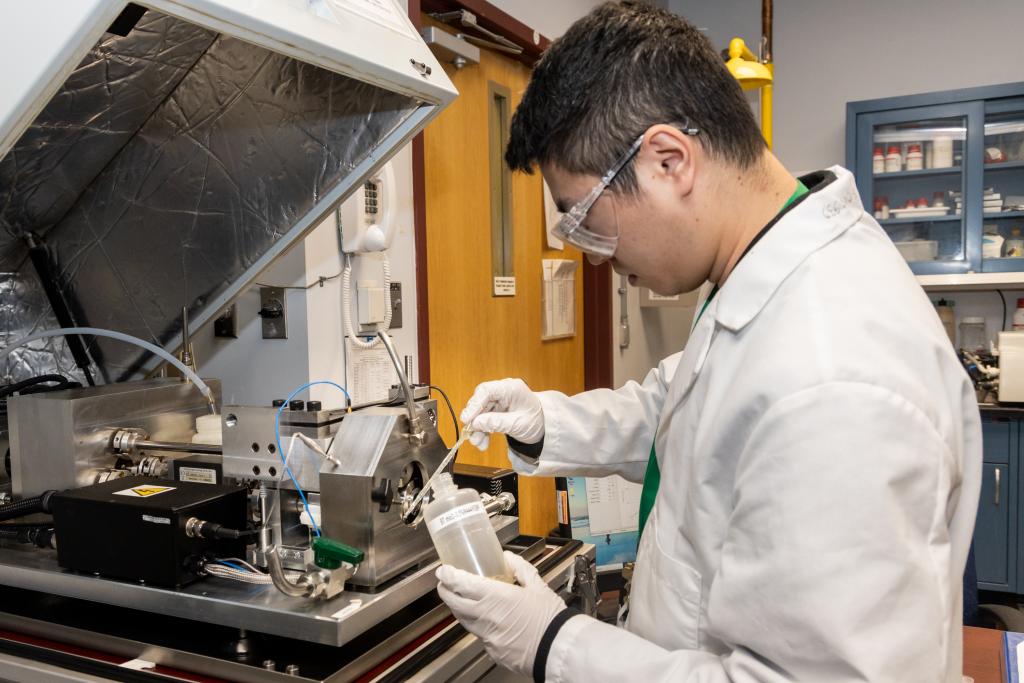Project Details

Overview/Objective
Marine energy leverages the natural movement of water like waves, tides, and river and ocean currents to generate electricity. Because these energy resources are predictable, they are promising contributors to a stable, reliable electricity grid. Though marine energy devices have been developed, the field currently faces a few logistical challenges that hinder widespread adoption of this otherwise promising technology. One of them is that the lubricants used to keep the machinery running require chemical additives that are either toxic, and therefore could gravely contaminate the aquatic environment, or they are not effective.
To that end, scientists at Oak Ridge National Laboratory sought to design, synthesize and test nontoxic but high-functioning additives for use in turbines installed in aquatic environments. A team of materials science and environmental researchers saw potential in ORNL’s newly invented ionic liquids (ILs) of ammonium phosphate and phosphonium phosphate, organic liquid salts that mix well with oil, are stable in a range of temperatures and conditions and reduce friction and wear for bearings and gears. They further focused in on ILs with hydrocarbon chains that contained fewer than six carbon atoms, which are generally considered to be less toxic.
The team was looking for a substance that consistently demonstrated the following properties:
- High-performing from a lubrication standpoint
- Nontoxic to aquatic organisms
- Readily biodegradable
The candidate substances also had the advantage of being straightforward to manufacture and easily scalable for commercial use.
Results
To test the lubricating efficacy of the candidate additives, scientists at the Physical Sciences Directorate conducted friction testing with metal pieces designed to simulate turbine gears and bearings, then examined the pieces using electron microscopy at the Center for Nanophase Materials Sciences, a DOE Office of Science user facility at ORNL. When added to base oils, the ILs demonstrated 50% less friction and a tenfold decrease in wear losses compared to a commercial gear oil.
To measure the additives’ environmental impact, the team then conducted toxicity and biodegradability tests at ORNL’s Environmental Toxicology Laboratory, a facility run by the Biological and Environmental Systems Science Directorate. The toxicity tests were conducted on a type of a tiny aquatic organism called Ceriodaphnia, commonly known as water fleas.
The findings showed that the environmentally acceptable lubricant (EAL) base oils had no effect on the water fleas. On the other hand, commercial lubricant additives and two of the previous IL compounds were found to be toxic to the organisms, resulting in 100% mortality within one to three days of exposure. However, the organisms fared much better when exposed to new, short-chain ammonium phosphate and phosphonium phosphate ILs as EAL additives, showing 90 to 100% survival rates after seven days.
The top-performing IL-enhanced lubricants were also found to be inherently or readily biodegradable during preliminary tests.
Impact
The discovery of high-performing, environmentally friendly lubricant additives is important for the safe and sustainable growth of marine energy, but also could have a positive impact that extends far beyond this specific field.
According to the Department of Energy, each year the US consumes about 2.47 billion gallons of lubricating oil in engines, industrial machinery and other uses, both on land and at sea. About half of that oil eventually finds its way into the environment. ORNL's research provides fundamental understanding that will aid future development of other eco-friendly ILs to be used in a wide variety of settings, which could ultimately result in a healthier, cleaner environment all around.
This team will next focus on further development of IL lubricant additives customized specifically for use in tidal turbines operating in the ocean, which are exposed to potential seawater contamination, corrosive conditions and pressure and temperature extremes.
This project was sponsored by the Vehicle Technologies Office, the Marine Energy Program of the Water Power Technologies Office, the Office of Energy Efficiency & Renewable Energy, and the ORNL Technology Innovation Program, all of which ultimately fall under the auspices of the U.S. Department of Energy.







